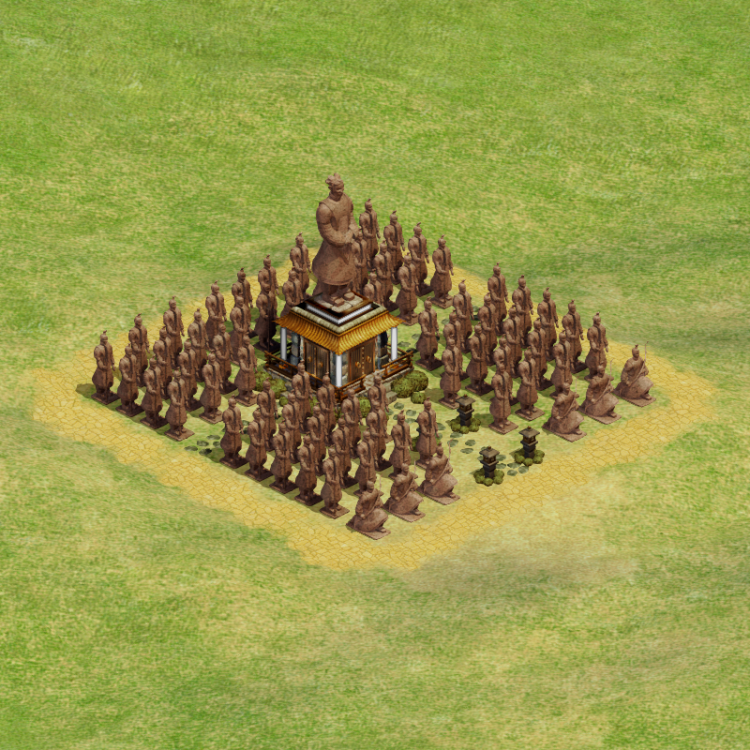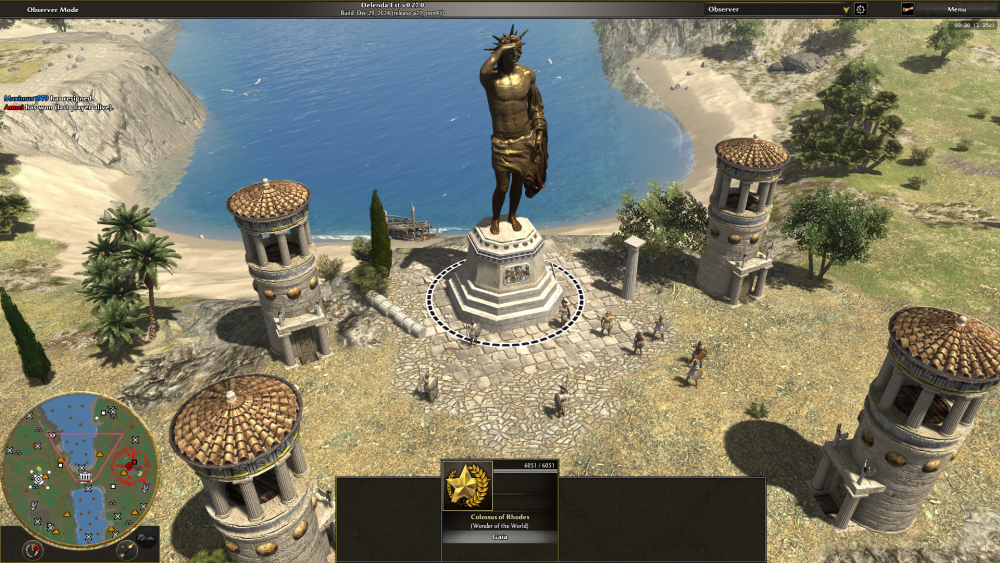-
Posts
25.684 -
Joined
-
Days Won
301
Everything posted by Lion.Kanzen
-
.thumb.png.ce58cea22940c255f5b0a735d5abee36.png)
Civilization Proposal: Arabs/ Rashidun Caliphate/ Umayyads
Lion.Kanzen replied to Mega Mania's topic in 1,000 A.D.
-
.thumb.png.ce58cea22940c255f5b0a735d5abee36.png)
==[TASK THREAD]== Wonders of the World
Lion.Kanzen replied to wowgetoffyourcellphone's topic in Official tasks
-
.thumb.png.ce58cea22940c255f5b0a735d5abee36.png)
[Brainstorming] Wonders of the World gameplay
Lion.Kanzen replied to Lion.Kanzen's topic in Gameplay Discussion
Capture Wonder is like King of the Hill mode. -
.thumb.png.ce58cea22940c255f5b0a735d5abee36.png)
[Brainstorming] Wonders of the World gameplay
Lion.Kanzen replied to Lion.Kanzen's topic in Gameplay Discussion
Defend Wonder... -
.thumb.png.ce58cea22940c255f5b0a735d5abee36.png)
[Brainstorming] Wonders of the World gameplay
Lion.Kanzen replied to Lion.Kanzen's topic in Gameplay Discussion
What wonders were there in Asia? In China and India? Edit: 1. The Army That United China: Qin Shi Huang's Mausoleum The mausoleum was commissioned by Qin Shi Huang, the emperor who ruled the first Chinese empire (the Qin Empire, 221–206 BC). The best known part of this huge complex is the Terracotta Warriors. It is China's most impressive mausoleum and unique in the world. -
.thumb.png.ce58cea22940c255f5b0a735d5abee36.png)
[Brainstorming] Wonders of the World gameplay
Lion.Kanzen replied to Lion.Kanzen's topic in Gameplay Discussion
If we mix several victory conditions, like in the future we will have score gameplay as a victory condition. It would be nice to give a score boost if you capture a wonder of the world. -
Yes, but you can have a defense map style skirmish, like defense of Crete. I don't know that map in depth.
-
Except Babylon gardens (by now/current state)
-
Let's discuss how to use our featured wonders, the big and majestic ones. Ideas range from map proposals to game modes, scores, etc. The idea came from this discussion, but I want to focus on the new statues and other unused buildings.
-
Capturing the wonders of the ancient world can earn you many score points.
-
What about the defense of Rodhes?
-
I'd like to make these more interesting. I'd like to add Wonders of the World to some maps and make them different and unique. This one I would rename to "Capture the Colossus." The idea reminds me of: the defense of Crete. https://ageofempiresonline.fandom.com/wiki/Defense_of_Crete
-
.thumb.png.ce58cea22940c255f5b0a735d5abee36.png)
Increasing social media markting effort for 0ad visibility
Lion.Kanzen replied to Darkcity's topic in General Discussion
I would have to use it on my second cell phone, because my WiFi is not very good at the moment. Because it doesn't come directly from the cable but from the 4G signal. Maybe that's why the FB Business app is failing. -
.thumb.png.ce58cea22940c255f5b0a735d5abee36.png)
Narrative Campaign General Discussion?
Lion.Kanzen replied to Lion.Kanzen's topic in Gameplay Discussion
Another source: Carthago Nova (modern-day Cartagena) was a city on the southern Iberian Peninsula, Spain, originally known as Mastia. Human habitation of the region predates the Neolithic Period, but the area around the site of Carthago Nova seems to have been sparsely populated until after the Bronze Age when a port city was built on a peninsula jutting into the Mediterranean Sea. The 4th-century AD Latin poet Rufus Festus Avienus identified Mastia with Massia of the Tartessians but that city was located in the region of the Tartessian Confederation around the ancient city of Carteia (near Gades, modern-day Cadiz), although the Tartessians almost certainly traded with Mastia and, according to some scholars, were the original inhabitants of the region. The city of Mastia was a known trade center of the Phoenicians (who may have founded it) and who traded with the Tartessians, well-known for their production of silver. Scholar B. H. Warmington, following earlier scholars, identifies Tartessos (in the region around Cadiz) with Tarshish from the Bible (Genesis 10:4, I Chronicles 1:7, Ezekiel 27:12, among others) and points out how similar the coastline around Cadiz is to that of ancient Mastia, thus explaining how ancient authors may have confused the two (though the site of biblical Tarshish has not been agreed on by any scholarly consensus). It has also been established that Mastia and Carteia were both known for their silver mines, wealth of resources, and their engagement in maritime trade. Hamilcar and his son Hannibal (l. 247-183 BC), along with his son-in-law Hasdrubal the Fair, went to Iberia allegedly to take the Iberian silver mines in order to pay Carthage's debt to Rome but, actually, to colonize the region and renew hostilities. https://www.worldhistory.org/Carthago_Nova/ -
.thumb.png.ce58cea22940c255f5b0a735d5abee36.png)
Narrative Campaign General Discussion?
Lion.Kanzen replied to Lion.Kanzen's topic in Gameplay Discussion
Mastia (or Massia of the Tartessians) is an ancient Iberian settlement, belonging to the Tartessian confederation, once located in southeastern Spain. It has traditionally been associated with the city of Cartagena (Spain).[1] The association has been made principally from the analysis of classical sources in the early 20th century by Adolf Schulten. The first description of the city of Mastia appears in a poem entitled Ora Maritima (Sea Coasts) by the Latin poet Rufius Festus Avienius from the 4th-century AD. The poem claims to contain borrowings from the mythic 6th-century BC Massiliote Periplus. The description of Avienus reads: ... then the port is Namnatio that from the sea opens its curve near the town of Massienos. And at the bottom of the Gulf rise the high walls of the city of Massia ... Rufius Festus Avienus, Ora Maritima. However, there is currently no conclusive evidence that the Mastia of Avienus refers to the same site where Cartagena will be founded. Context and other geographic descriptions that precede and follow these lines suggest that it could refer to the same location. Some scholars[who?] locate Mastia somewhere near the ancient city of Carteia (near modern Gibraltar), at the head of the Bay of Algeciras. In addition to the Ora Maritima, there is also a reference to Mastia in the treaty between Rome and Carthage of 348 BC, as Μαστια Ταρσειων (Mastia of the Tartessians), which marked the Roman boundary on the Iberian Peninsula. For Hecataeus of Miletus know that some cities were dependent on or under the influence of Mastia field and mentioned: Sixos of the Mastians. The only one that can be confidently identified. It corresponds to the current Sexi (Almuñécar) Maniobora of the Mastians. Molybdine of the Mastians. Syalis of the Mastians. Its mineral wealth, fisheries, and agriculture was the cause of the Kingdom of Tartessos keeping it in their area of influence. https://en.m.wikipedia.org/wiki/Mastia -
.thumb.png.ce58cea22940c255f5b0a735d5abee36.png)
Increasing social media markting effort for 0ad visibility
Lion.Kanzen replied to Darkcity's topic in General Discussion
Yes, I still have access and so does Lopess. But on mobile it requires me to use the FB Business app. I need to try on the computer. -
.thumb.png.ce58cea22940c255f5b0a735d5abee36.png)
Narrative Campaign General Discussion?
Lion.Kanzen replied to Lion.Kanzen's topic in Gameplay Discussion
Mastia should be nearby in case of a new settlement. That also happens in the ancient world. An old city close to a new, better established one. -
.thumb.png.ce58cea22940c255f5b0a735d5abee36.png)
Narrative Campaign General Discussion?
Lion.Kanzen replied to Lion.Kanzen's topic in Gameplay Discussion
Objectives: defeat Iberian settlement, destroy CC or capture CC. Then build walls, build a Mining building ( warehouse) collect silver from local mine. Build a market. Cr are a trade route. +++++ Opinions? -
.thumb.png.ce58cea22940c255f5b0a735d5abee36.png)
Narrative Campaign General Discussion?
Lion.Kanzen replied to Lion.Kanzen's topic in Gameplay Discussion
It seems, however, that the city was not founded ex novo, but was built on a previous Iberian or Tartessian settlement. There is evidence of trade with the Phoenicians from the eighth century BC along the coast. In addition, Cartagena has traditionally been associated with the city of Mastia mentioned by the Greco-Latin poet Avieno in the work called Ora maritima (which gathers the oldest preserved news about the Iberian Peninsula), and also mentioned in the second Roman-Carthaginian treatise in 348 B.C. as Mastia Tarseion (Mastia of the Tartessians). -
.thumb.png.ce58cea22940c255f5b0a735d5abee36.png)
Narrative Campaign General Discussion?
Lion.Kanzen replied to Lion.Kanzen's topic in Gameplay Discussion
Carthage Nova was founded around 227 BC under the name of Qart Hadasht (New City) by the Carthaginian general Asdrubal the Beautiful, son-in-law and successor of General Hannibal's father Hannibal Hamilcar Barca. Carthage Nova is the most important of the cities of the peninsula, owing to a strong position and a well-built wall, and is provided with harbors, lagoons and silver mines.[1] In Carthage Nova and the surrounding cities there is salting in abundance, and it is the chief emporium for goods coming from the sea destined for the inhabitants of the interior, and for products from the interior destined for foreigners. https://es.m.wikipedia.org/wiki/Cartago_Nova Spanish wiki( English version not avaible). -
.thumb.png.ce58cea22940c255f5b0a735d5abee36.png)
Narrative Campaign General Discussion?
Lion.Kanzen replied to Lion.Kanzen's topic in Gameplay Discussion
That's why it has to be done as a team. It would be good if we all saw the map and decided how to proceed. -
.thumb.png.ce58cea22940c255f5b0a735d5abee36.png)
Increasing social media markting effort for 0ad visibility
Lion.Kanzen replied to Darkcity's topic in General Discussion
We have a lot of Spanish audience judging by the names and comments in Spanish. At least on Facebook. -
.thumb.png.ce58cea22940c255f5b0a735d5abee36.png)
Increasing social media markting effort for 0ad visibility
Lion.Kanzen replied to Darkcity's topic in General Discussion
I imagined something similar.






